Island Stories:
![]() Danzig
Mine
Danzig
Mine
![]() Zeballos
Iron Mine
Zeballos
Iron Mine
![]() Conuma
Peak 1910
Conuma
Peak 1910
Alexandra Peak
Argus Mountain
Bate/Alava Sanctuary
Beaufort Range
Big Interior Mtn
Big Interior Mtn 1913
Part 1
Part 2
Bolton Expedition 1896
Cliffe Glacier
Clinton Wood
Comox Glacier
Comox Glacier 1922
Comox Glacier 1925
Comstock Mtn
Conuma Peak
Copper King Mine
Crown Mtn
Elkhorn 1912
Elkhorn 1949
Elkhorn 1968
Eugene Croteau
Golden Bullets
Golden Hinde 1913/14
Golden Hinde 1937
Golden Hinde 1983
Harry Winstone Tragedy
Jack Mitchell
Jim Mitchell Tragedy
John Buttle
Judges Route
Koksilah's Silver Mine
Landslide Lake
Mackenzie Range
Malaspina Peak
Mariner Mtn
Marjories Load
Matchlee Mountain
Mount McQuillan
Mt. Albert Edward
Mt. Albert Edward 1927
Mt. Albert Edward 1938
Mt. Becher
Mt. Benson 1913
Mt. Benson
Mt. Doogie Dowler
Mt. Colonel Foster
Mt. Hayes/Thistle Claim
Mt. Maxwell
Mt. Sicker
Mt. Tzouhalem
Mt. Whymper
Muqin/Brooks Peninsula
Nine Peaks
Queneesh
Ralph Rosseau 1947
Rosseau Chalet
Ralph Rosseau Tragedy
Rambler Peak
Red Pillar
Rex Gibson Tragedy
Sid's Cabin
Steamboat Mtn
Strathcona Park 1980's
The Misthorns
The Unwild Side
Victoria Peak
Waterloo Mountain 1865
Wheaton Hut/Marble Meadows
William DeVoe
Woss Lake
You Creek Mine
Zeballos Peak
Other Stories:
Sierra
de los Tuxtlas
Antarctica
Cerro del Tepozteco
Citlaltepetl
Huascaran
Mt. Roraima
Nevada Alpamayo
Nevada del Tolima
Nevado de Toluca
Pico Bolivar
Popocatepetl
Uluru/Ayers Rock
Volcan Purace
Volcan San Jose
Biographies
Island 6000
Cartoons
Order the Book
Contact Me
Links

Mariner
Mountain:
Or
Searching for the Grail on the Holy Cross
by Lindsay Elms
When it came to climbing around the mountains there weren't too many places prospectors in the late 1800's and early to mid 1900's couldn't get to. It was the lure of gold and the excitement of possibly finding the mother lode and striking it rich. Every prospector dreamed about this and with every find that feeling would get stronger! However, it was like finding a needle in the haystack as a rich Quartz bearing vein containing enough of the valuable mineral might only be twenty centimeters wide on the surface, covered with moss and surrounded by tall trees or steep bluffs. It took a sharp eye, some basic knowledge on geology and a lot of luck to be successful. On Vancouver Island one area that saw prospectors scouring the adjacent mountains with their fingers crossed was the Bedwell Valley.
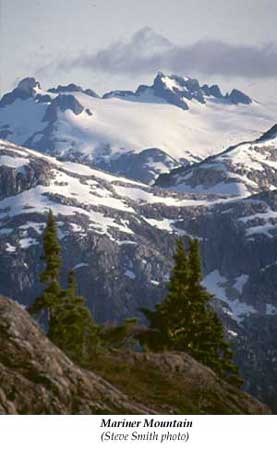 Creeks
cascading from the surrounding mountains were inspected and hanging valleys
and gulches where minerals might lie trapped saw prospectors staking claims
and working hard to make a living. Although they hiked nearly every square
inch of the mountains, many of the summits were rarely visited. Usually
minerals were found lower down on the slopes. Of course one exception
was Big
Interior Mountain (1,857m) at the head of the Bedwell
River where a rich claim containing copper and a hint of gold was found.
The range of mountains between the Bedwell River and the Moyeha River
were no exceptions. From Abco Mountain (1,526m) above Moyeha Bay and east
to Mount Cotter (1,200m) at the head of Penny Creek then north to Mariner
Mountain (1,778m) or Holy Cross Mountain as it was originally called,
prospectors searched for the allusive gold bearing quartz.
Creeks
cascading from the surrounding mountains were inspected and hanging valleys
and gulches where minerals might lie trapped saw prospectors staking claims
and working hard to make a living. Although they hiked nearly every square
inch of the mountains, many of the summits were rarely visited. Usually
minerals were found lower down on the slopes. Of course one exception
was Big
Interior Mountain (1,857m) at the head of the Bedwell
River where a rich claim containing copper and a hint of gold was found.
The range of mountains between the Bedwell River and the Moyeha River
were no exceptions. From Abco Mountain (1,526m) above Moyeha Bay and east
to Mount Cotter (1,200m) at the head of Penny Creek then north to Mariner
Mountain (1,778m) or Holy Cross Mountain as it was originally called,
prospectors searched for the allusive gold bearing quartz.
Although numerous people searched the Bedwell Valley one of the most important characters was Walter Guppy who lived in Tofino. When Walter turned eighteen in 1936 he qualified to purchase a Free Miner's Certificate and struck out on his own as a prospector. Zeballos boomed in that year but gold fever was already rife on the coast. Thus began Walter's obsession with the Bedwell and surrounding valleys, which continued on into 1999 when his health began to fail him.
One mountain that Walter spent considerable time searching its slopes was Mariner Mountain. Walter could see Mariner Mountain from his living room window and in one of his books he related how someone had told his mother that this prominent mountain was called "The Sleeping Giant," however, Walter found it difficult to see the likeness of a human form in its crags and peaks. Walter wrote that Mariner Mountain: "…is impressive with its vast expanse of bare rock (bigger than any clear-cut) broken only by its glacier which recedes to some extent but is still of considerable proportions even at the end of summer."
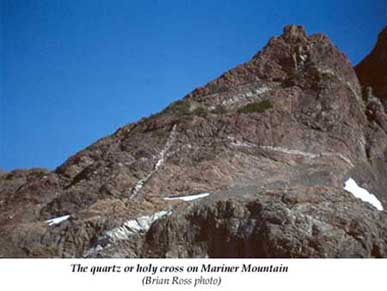 Access
to the slopes of Mariner Mountain was via a trail built up Noble Creek
by a party of prospectors who staked the Belvedere group on September
18, 1898. This claim was Crown granted in 1911. The party included the
Von Brendel's who held pre-empted land at the head of Bedwell Sound at
the turn of the century and built a homestead, which was later passed
on to their son John Von Brendel. In the 1960's Walter used this trail
to access a boulder-strewn gully to the east of Noble Creek that was locally
referred to as "Dry Gulch." Here he staked the Cub group of
fourteen claims that overlapped some of the Belvedere group and some showings
formerly held by Noble Cornelius after whom the Noble Creek is named.
Walter wrote that precipitous slopes fringed the surrounding gulches and
he concluded that it was only the lower section of the property that was
even remotely accessible and then only by experienced alpinist or mountain
goats. He believed the gold showings which occur in interlacing quartz
stringers in the granodiorite rock in the gully had the potential to be
a feasible mining operation but it was the low copper assays that geologists
from the Utah Construction Company looked at and determined that a mine
wasn't viable. Later changing political situations and the rising tide
of environmentalism eventually ruled against the possibility of Walter
being able to do anything with this property.
Access
to the slopes of Mariner Mountain was via a trail built up Noble Creek
by a party of prospectors who staked the Belvedere group on September
18, 1898. This claim was Crown granted in 1911. The party included the
Von Brendel's who held pre-empted land at the head of Bedwell Sound at
the turn of the century and built a homestead, which was later passed
on to their son John Von Brendel. In the 1960's Walter used this trail
to access a boulder-strewn gully to the east of Noble Creek that was locally
referred to as "Dry Gulch." Here he staked the Cub group of
fourteen claims that overlapped some of the Belvedere group and some showings
formerly held by Noble Cornelius after whom the Noble Creek is named.
Walter wrote that precipitous slopes fringed the surrounding gulches and
he concluded that it was only the lower section of the property that was
even remotely accessible and then only by experienced alpinist or mountain
goats. He believed the gold showings which occur in interlacing quartz
stringers in the granodiorite rock in the gully had the potential to be
a feasible mining operation but it was the low copper assays that geologists
from the Utah Construction Company looked at and determined that a mine
wasn't viable. Later changing political situations and the rising tide
of environmentalism eventually ruled against the possibility of Walter
being able to do anything with this property.
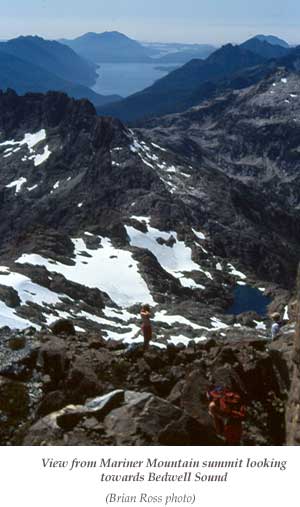 However,
it is this trail that the prospectors built to reach their claims that
mountaineers now use to access Mariner Mountain on their quest to reach
the summit of one of the remote high glaciated mountains on the island.
The trail leaves the Bedwell River and winds up the south side of Noble
Creek to the col immediately to the south of Mariner Mountain. Although
the trail is infrequently used and the occasional stretches of old cedar
boards are now covered with a thick veneer of moss the trail follows a
natural line and is therefore easy to locate. From the col the route ascends
towards the obvious white quartz cross in the rock, hence the name Holy
Cross Mountain. This cross is clearly visible by mariners out at sea and
was used as a reference point when sailing up the west coast.
However,
it is this trail that the prospectors built to reach their claims that
mountaineers now use to access Mariner Mountain on their quest to reach
the summit of one of the remote high glaciated mountains on the island.
The trail leaves the Bedwell River and winds up the south side of Noble
Creek to the col immediately to the south of Mariner Mountain. Although
the trail is infrequently used and the occasional stretches of old cedar
boards are now covered with a thick veneer of moss the trail follows a
natural line and is therefore easy to locate. From the col the route ascends
towards the obvious white quartz cross in the rock, hence the name Holy
Cross Mountain. This cross is clearly visible by mariners out at sea and
was used as a reference point when sailing up the west coast.
Whether the early prospectors actually climbed to the summit of Mariner Mountain and who and when that occurred is anyone's guess, however, the summit towers of this mountain have lured a few mountaineers over the years. As already mentioned, access via Noble Creek is the easiest route and the ascent is usually completed in a three day round trip but there is a beautiful multi-day traverse from Bedwell Lake up Mount Tom Taylor and down to Mariner Mountain which can then be exited at either Bedwell Sound via Noble Creek or Herbert Inlet (Moyeha Bay) via Abco Mountain.
The first recorded traverse from Mount Tom Taylor to Mariner Mountain happened in June/July 1985. Paul Erickson and Rob Macdonald, members of the Vancouver Island section of the Alpine Club of Canada, had long talked about climbing Mariner Mountain but it took a few beers as a catalyst and the arm-twisting of Ken Denman and Rick Eppler that finally saw a plan evolve from the bar table to reality.
On June 28, 1985, Doug Banks of Tofino Air flew in the four to Bedwell Lake where they arrived shortly after noon. After traversing around a couple of lakes that also form the headwaters of the Bedwell River, they then struck up the East Ridge of Mount Tom Taylor. By 7 p.m. they were on the summit ridge but with the weather being good they pressed on. They found Tom Taylor's North Ice-field a willing highway and eventually after numerous ups and downs stopped at the end of the Southwest Ridge satisfied with the day's progress.
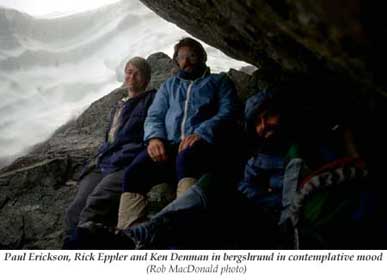 The
next day with the weather changing they picked their way down of the end
off the ridge and up a prominent gully to gain the ridge leading to Mariner
Mountain. At this point the weather decided to stop threatening and actually
do something - rain! They continued along the ridge, traversing the east
side in rain and fog, both of which had become progressively worse. Arriving
at a col, which was an obvious feature on the map, they decided to put
their tents up and get out of the rain which had by now made them soaking
wet and cold.
The
next day with the weather changing they picked their way down of the end
off the ridge and up a prominent gully to gain the ridge leading to Mariner
Mountain. At this point the weather decided to stop threatening and actually
do something - rain! They continued along the ridge, traversing the east
side in rain and fog, both of which had become progressively worse. Arriving
at a col, which was an obvious feature on the map, they decided to put
their tents up and get out of the rain which had by now made them soaking
wet and cold.
It rained and snowed for most of the night, but things improved toward dawn; enough that they were able to hang things out to dry. Now they began to waffle: should they drag their packs on up Mariner Mountain and continue with the plan to traverse to Abco Mountain or bag Mariner and make a run for the Bedwell. It's easy when you are on your own but with a party of four it can be difficult to come to a group consensus. Eventually they decide to keep going with the original plan and pushed on but again the rain and fog set in. Moral was getting low and while huddling under a bergschrund they finally decided to abandon their packs and give up on the idea of traversing across to Abco Mountain. They had lost too much time but the summit of Mariner Mountain was still a possibility. Armed with a topographical map and an aerial photograph for navigation they were able to grope their way by keeping recognizable features in sight. This way they could not get lost. Macdonald wrote:
As we traversed the large snowfields under the rock ridges which stuck up everywhere, the weather and clouds started to lift and we could see what a little Island gem this place was. It was therefore a letdown to find evidence of previous exploration in the form of a rusty nail hammered into the summit. A cairn would have sufficed. Under improving weather we went over and bagged the east summit as well. After a couple of gendarmes we dropped back to the packs and down to a decent campsite.
The next day looked so fine we decided to return to the summit snowfields and climb some of the outliers, particularly the line of four trending north. The weather was perfect and we virtually climbed everything in sight. It was sound rock and the ascents were made from the south
After a day of rampant climbing they then had to contend with a bushwhack down to the Bedwell River coming out almost opposite Sam Craig Creek. They were obviously unaware of the prospectors trail down Noble Creek. Once in the Bedwell they found the old overgrown logging road and were picked up the next day on schedule at mouth of the Bedwell River.
Since then
several other parties have made that same traverse but most climbers ascend
Mariner Mountain via Noble Creek and the old prospectors trail. Of the
mining there is very little evidence visible, as the vegetation grows
back over things very quickly, however, on the col to the south of Mariner
Mountain a significant source of magnetite was found by Bert Clayton and
Joe Felber. Today, several mine adits and old mining equipment can still
be found on the col; proof of some of the extensive prospecting that occurred
on the mountains surrounding Bedwell River.
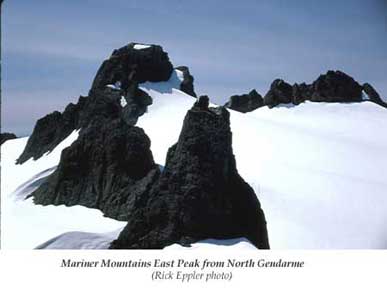 |
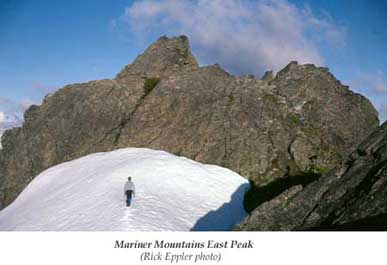 |
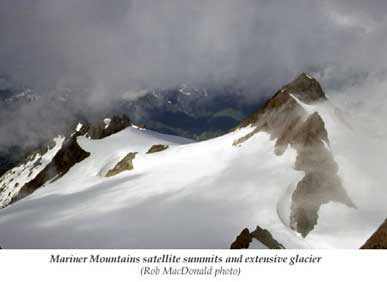 |
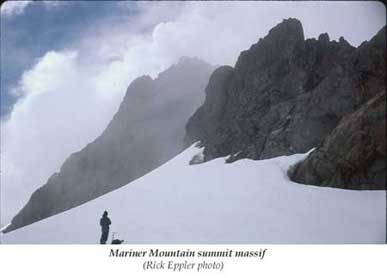 |
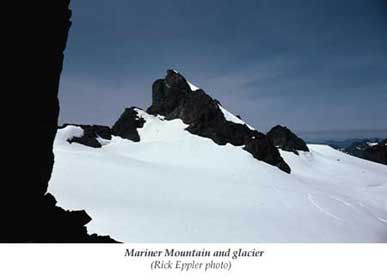 |
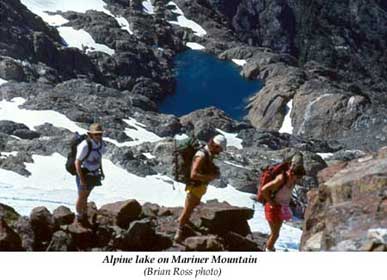 |
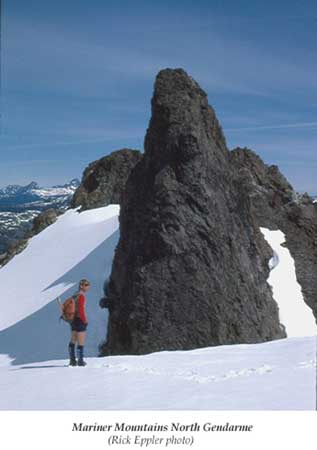 |
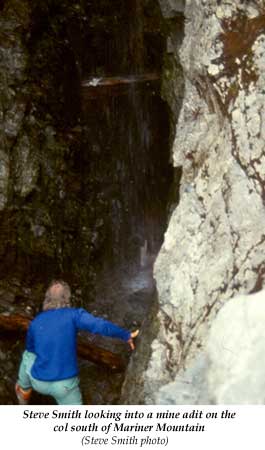 |
How to order | | About the Author || Links || Home
Contact:
Copyright ©
Lindsay Elms 2001. All Rights Reserved.
URL: http://www.beyondnootka.com
http://www.lindsayelms.ca